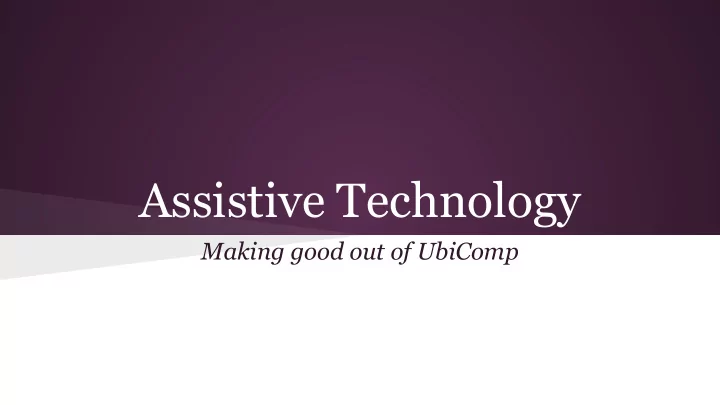

Assistive Technology Making good out of UbiComp
Today’s Class 1. Technology in Assistance 2. Google Glass for PD a. PD overview b. Step through article with questions 3. Pervasive Computing and Assistive Tech a. Autism overview b. Step through article with questions 4. Other Work
Technology in Assistance Two main roles 1. Enabling individuals to use existing technology 2. Measuring something to manage the condition
Exploring the Acceptability of Google Glass for People with Parkinson’s Roisin McNancey and John Vines
Parkinson’s Disease (PD) ● Tremor ● Slowed movement ● Rigid muscles ● Impaired posture and balance ● Loss of automatic movements ● Speech changes ● Writing changes
Evaluation: ● 5 PD patients for workshop discussions ● 2 Carers ● 4 PD patients for 5 day field trial ● Phone interviews for day trials everyday
Google Glass and PD:
Workshop!? Open discussion!?
Issues and frustrations with other existing technologies!!!!!!!
Workshop Concerns ● Confidence: Independence for PD patients ● Safety: If you fall, you can call ● Security: Street swipers ● Privacy: Big brother is watching
Field Trials!? Open discussion!? Solve the mystery of the missing PF4 and never write a summary again!
Attention in public places: ● Fleeting attention? Visual impairment? [PF5] ● “No notice” [PM1] ● People staring?[PM3] Does the design matter?
Pros Cons ● SatNav ● Voice recognition ● Search engines ● Navigation gestures ● Speed (Tapping)
Possible Improvements: ● Contextual reminders and prompts ● In-sight task support ● Cueing for self-management
Other improvements?
Pervasive Computing and Autism Julie Kientz, Gillian Hayes, Tracy Westeyn, Thad Starner, and Gregory Abowd
Autism Impairment: ● Communication ● Social interactions ● Creativity “‘If you’ve seen one child with autism, you’ve seen one child with autism.’”
Three Technologies 1. Abaris: Indexing videos 2. CareLog: DVR for Autism care 3. Wearable Sensors: Stimming detection
Design Considerations Preparation: ● Interviews ● Trained and practiced therapy Discovery: ● Adjustments are catastrophic ● Dynamic system for variant behaviors
Design Challenges ● Uncooperative subjects ● Wearable hardware ● Ethics/Privacy
Other Work Using Augmented Reality to Help Children with Autism Stay Focused ● Current teaching practices: repetition ● MOBIS, a new way of teaching
Other Work
Future Work 1. Early Detection: Developmental tracking 2. Collaboration: Focus on child, not behavior tracking 3. Misc Autism Research: Sleep pattern tracking & stress detection 4. Sound Analysis: Vocal stimming detection
Questions?
Recommend
More recommend